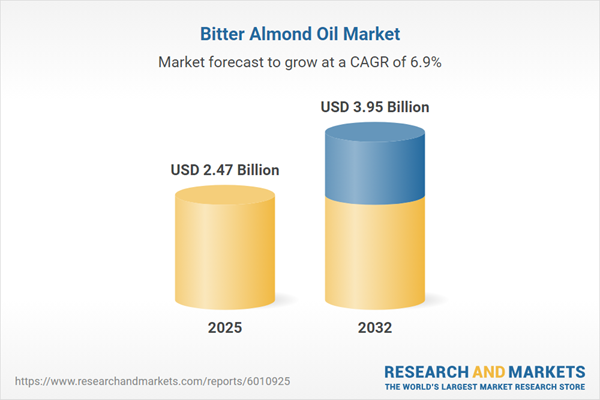Speak directly to the analyst to clarify any post sales queries you may have.
The bitter almond oil market is undergoing notable change as evolving regulations and technological advances shape supply, demand, and procurement practices. Senior executives are turning to agile frameworks and targeted strategies to capture emerging commercial opportunities while navigating global complexities.
Bitter Almond Oil Market Snapshot: Size and Trajectory
The bitter almond oil market reached USD 2.31 billion in 2024, with growth steadily advancing toward USD 2.47 billion by 2025. This robust trajectory is sustained by multi-sector interest, as organizations in cosmetics, food and beverage, fragrance, and pharmaceuticals require reliable sourcing and versatile applications. Suppliers focus on building strategic alliances, refining procurement models, and engineering targeted product solutions to navigate market volatility. Senior decision-makers balance growth initiatives with precise risk management, ensuring operational adaptability as demand diversifies across industries.
Bitter Almond Oil Market: Scope & Segmentation
- Application Areas: Bitter almond oil is utilized in hair care, skincare, makeup, food and beverage, confectionery, deodorant, perfume, and pharmaceutical formulations. Its analgesic and anti-inflammatory characteristics align with sector-specific requirements, making it relevant for both well-established and emerging markets.
- End User Industries: Buyers include cosmetics, food and beverage, personal care, and pharmaceutical organizations. Each of these sectors focuses on regulatory consistency and resilient supply chains, facilitating innovation and supporting consumer trust.
- Product Types: The market offers conventional food-grade, technical-grade, and organic variants. These product types enable companies to address certification requirements and to respond to both localized and international market preferences seamlessly.
- Distribution Channels: Procurement occurs via online platforms, supermarkets, hypermarkets, B2B direct channels, and wholesale networks, allowing industry buyers to access bulk quantities and diversify their sourcing strategies.
- Geographic Regions: Coverage includes North America, Latin America, Europe, Middle East and Africa, and Asia-Pacific. Regional approaches are necessary to reflect differences in local compliance needs, market dynamics, and consumer expectations.
- Key Market Players: Major participants such as GIVAUDAN SA, Firmenich International SA, McCormick & Company, Robertet SA, Berjé Inc, and Edens Garden, Inc. implement stringent quality management, responsive pricing, and flexible procurement to maintain competitiveness in multiple regions.
Key Takeaways for Senior Decision-Makers
- Advanced extraction technologies, including cold-pressing and supercritical CO₂, are driving increased oil purity and enabling sector-specific formulations across end uses.
- Transparent supply chain management, paired with documented compliance, fosters clean-label validation and supports organic certification efforts.
- Investment in digital procurement platforms and supplier network expansion is enhancing sourcing agility, supporting organizations in countering unexpected operational disruptions.
- Collaboration between producers and manufacturers is fueling the launch of tailor-made products, enhancing responsiveness to changes in global and regional regulations and evolving buyer criteria.
- Deploying regionalized strategies enables organizations to meet local compliance standards and address distinct buyer behaviors and preferences within different international markets.
Tariff Impact: Adjusting Sourcing Strategies in the United States
Recent shifts in U.S. tariff regulations have prompted suppliers to diversify their sourcing into Asia and Latin America. By establishing new partnerships and manufacturing bases across these regions, organizations gain greater resilience and limit exposure to shifting trade costs. This approach strengthens supply stability and safeguards against sudden disruptions linked to global trade developments.
Methodology & Data Sources
This analysis integrates direct feedback from supply chain, manufacturing, and distribution stakeholders, supplemented with a comprehensive literature review and scenario-based modeling. These sources ensure a practical, actionable perspective for executive-level decision-making in the bitter almond oil sector.
Why This Report Matters
- Empowers procurement and logistics professionals to improve supply chain visibility, manage risks, and realign sourcing as market conditions fluctuate.
- Supports innovation and new product initiatives with in-depth insights focused on specialty markets and advanced extraction trends.
- Equips compliance teams to navigate shifting global regulations and strengthen robust cross-border operations by providing critical intelligence.
Conclusion
Organizations that synchronize strategic initiatives with regulatory updates, prioritize innovation, and adapt business models to local distinctions build competitive and lasting market positions. Emphasizing transparency and flexibility is fundamental to sustaining resilience in a changing environment.
Additional Product Information:
- Purchase of this report includes 1 year online access with quarterly updates.
- This report can be updated on request. Please contact our Customer Experience team using the Ask a Question widget on our website.
Table of Contents
3. Executive Summary
4. Market Overview
7. Cumulative Impact of Artificial Intelligence 2025
Companies Mentioned
The companies profiled in this Bitter Almond Oil market report include:- GIVAUDAN SA
- Firmenich International SA
- McCormick & Company, Incorporated
- Robertet SA
- Berjé Inc
- Edens Garden, Inc.
Table Information
| Report Attribute | Details |
|---|---|
| No. of Pages | 185 |
| Published | October 2025 |
| Forecast Period | 2025 - 2032 |
| Estimated Market Value ( USD | $ 2.47 Billion |
| Forecasted Market Value ( USD | $ 3.95 Billion |
| Compound Annual Growth Rate | 6.9% |
| Regions Covered | Global |
| No. of Companies Mentioned | 7 |









